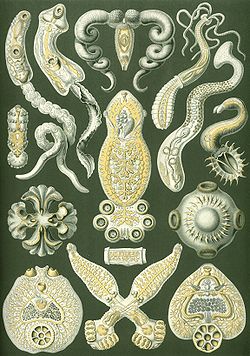Flatworm
| Flatworms | |
|---|---|

| |
| "Platodes" from Ernst Haeckel's Kunstformen der Natur, 1909 | |
| Scientific classification | |
| Kingdom: | |
| Subkingdom: | |
| Superphylum: | |
| Phylum: | Platyhelminthes
|
| Classes | |
| Wikimedia Commons has media related to Lua error in Module:Commons_link at line 62: attempt to index field 'wikibase' (a nil value).. |
Flatworm Media
The turbellarian Pseudoceros dimidiatus
Life cycle of the digenean Metagonimus
Silhouettes of bodies of various polyopisthocotylean Monogeneans
Life cycle of the eucestode Taenia: Inset 5 shows the scolex, which has four Taenia solium, a disk with hooks on the end. Inset 6 shows the tapeworm's whole body, in which the scolex is the tiny, round tip in the top left corner, and a mature proglottid has just detached.
| Wikispecies has information on: Platyhelminthes. |
Flatworms (Platyhelminthes, Greek "platy"': flat; "helminth": worm) are a phylum of invertebrates. They are relatively simple animals. They have soft bodies.
With about 25,000 known species, they are the largest phylum of animals without a body cavity. Flatworms can be found in marine, freshwater, and even damp terrestrial environments.[1]
A troublesome terrestrial example is the New Zealand flatworm, Arthurdendyus triangulatus. It is an invasive species which colonized large areas of Ireland and Scotland. It was brought there by accident in the 1960s. Since then, it has destroyed most of the indigenous earthworms.
Most free-living flatworms found in Britain are very small ranging from 5mm to less than 1 cm. They are usually black and can easily be mistaken for debris. These are mostly found in freshwater rivers or streams and are of the Turbellaria class.
Most flatworms (over 50%) are parasitic on other animals. There are four classes:
- Trematoda (Flukes): internal parasites.
- Cestoda (Tapeworms): internal parasites.
- Monogenea: external parasites.
and
- Turbellaria: free-living flatworms, sometimes called 'Planarians'. Planaria is actually a genus.
Flatworms are one of the invertebrate groups which are studied in school biology. The main reason for this is that they may infect humans, pets and farmyard animals. Some do enormous harm to humans and their livestock. Schistosomiasis, caused by one genus of trematodes, is the second most devastating of all human diseases caused by parasites, surpassed only by malaria. Effective treatments are now available for these infections. Also, in first-world countries, regulations on domestic cattle prevent infected meat from reaching the human hosts.
Related pages
References
- ↑ Walker J.C. & Anderson D.T.(2001. The Platyhelminthes. In Anderson D.T. (ed) Invertebrate Zoology. Oxford University Press. pp. 58–80. ISBN 978-0-19-551368-4







